engine coolant temperature Mercury Grand Marquis 2002 Owner's Manuals
[x] Cancel search | Manufacturer: MERCURY, Model Year: 2002, Model line: Grand Marquis, Model: Mercury Grand Marquis 2002Pages: 248, PDF Size: 1.81 MB
Page 9 of 248
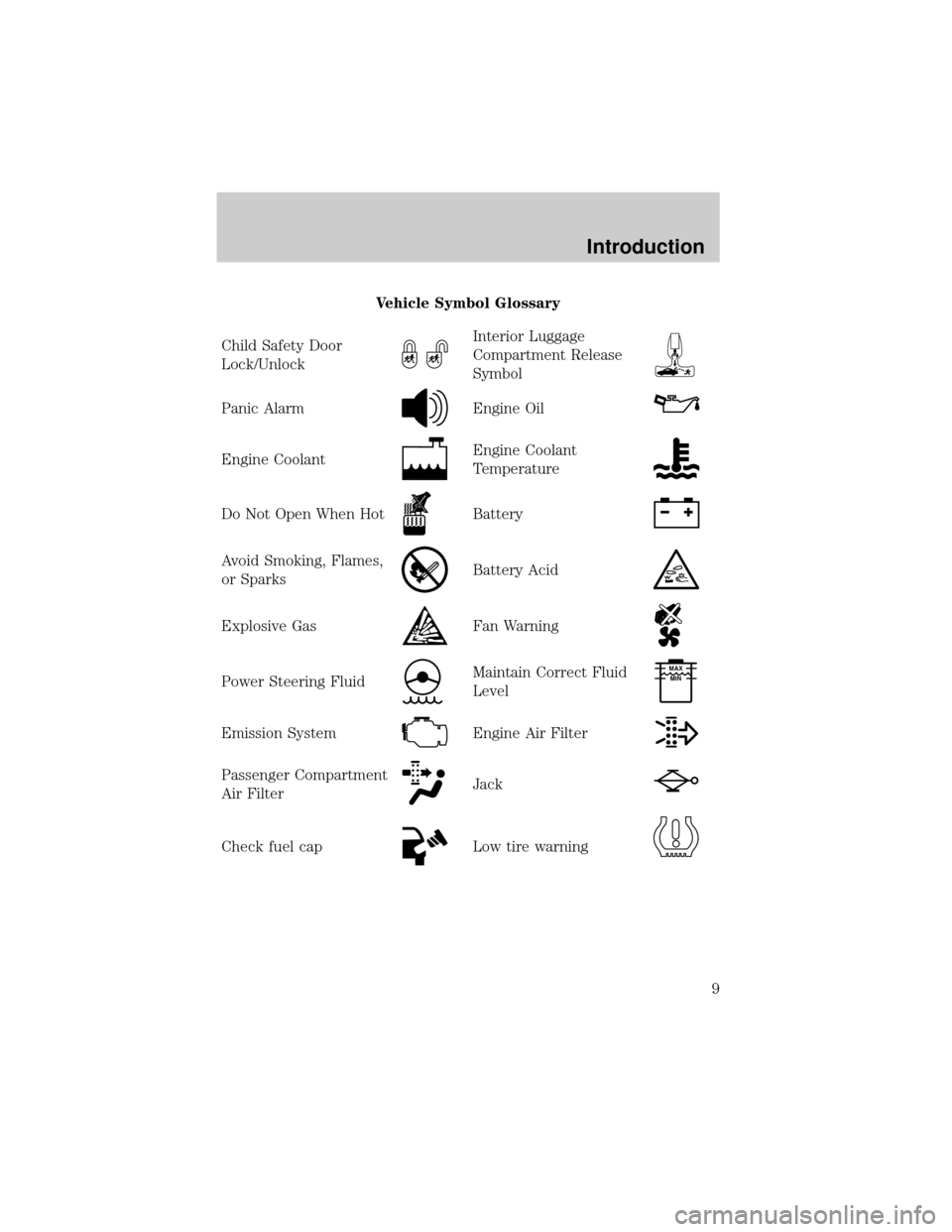
Vehicle Symbol Glossary
Child Safety Door
Lock/Unlock
Interior Luggage
Compartment Release
Symbol
Panic AlarmEngine Oil
Engine CoolantEngine Coolant
Temperature
Do Not Open When HotBattery
Avoid Smoking, Flames,
or SparksBattery Acid
Explosive GasFan Warning
Power Steering FluidMaintain Correct Fluid
LevelMAX
MIN
Emission SystemEngine Air Filter
Passenger Compartment
Air FilterJack
Check fuel capLow tire warning
Introduction
9
Page 13 of 248
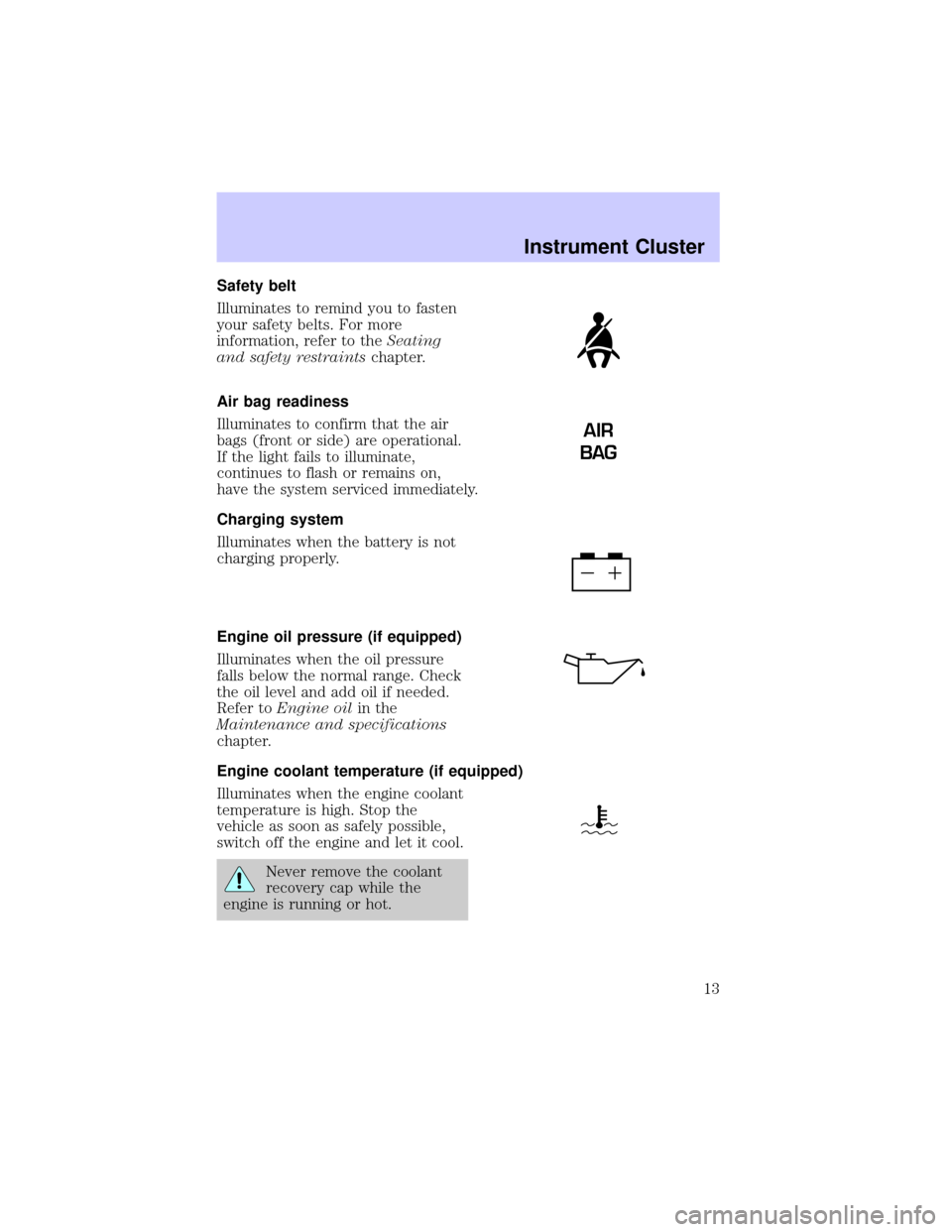
Safety belt
Illuminates to remind you to fasten
your safety belts. For more
information, refer to theSeating
and safety restraintschapter.
Air bag readiness
Illuminates to confirm that the air
bags (front or side) are operational.
If the light fails to illuminate,
continues to flash or remains on,
have the system serviced immediately.
Charging system
Illuminates when the battery is not
charging properly.
Engine oil pressure (if equipped)
Illuminates when the oil pressure
falls below the normal range. Check
the oil level and add oil if needed.
Refer toEngine oilin the
Maintenance and specifications
chapter.
Engine coolant temperature (if equipped)
Illuminates when the engine coolant
temperature is high. Stop the
vehicle as soon as safely possible,
switch off the engine and let it cool.
Never remove the coolant
recovery cap while the
engine is running or hot.
AIR
BAG
Instrument Cluster
13
Page 18 of 248
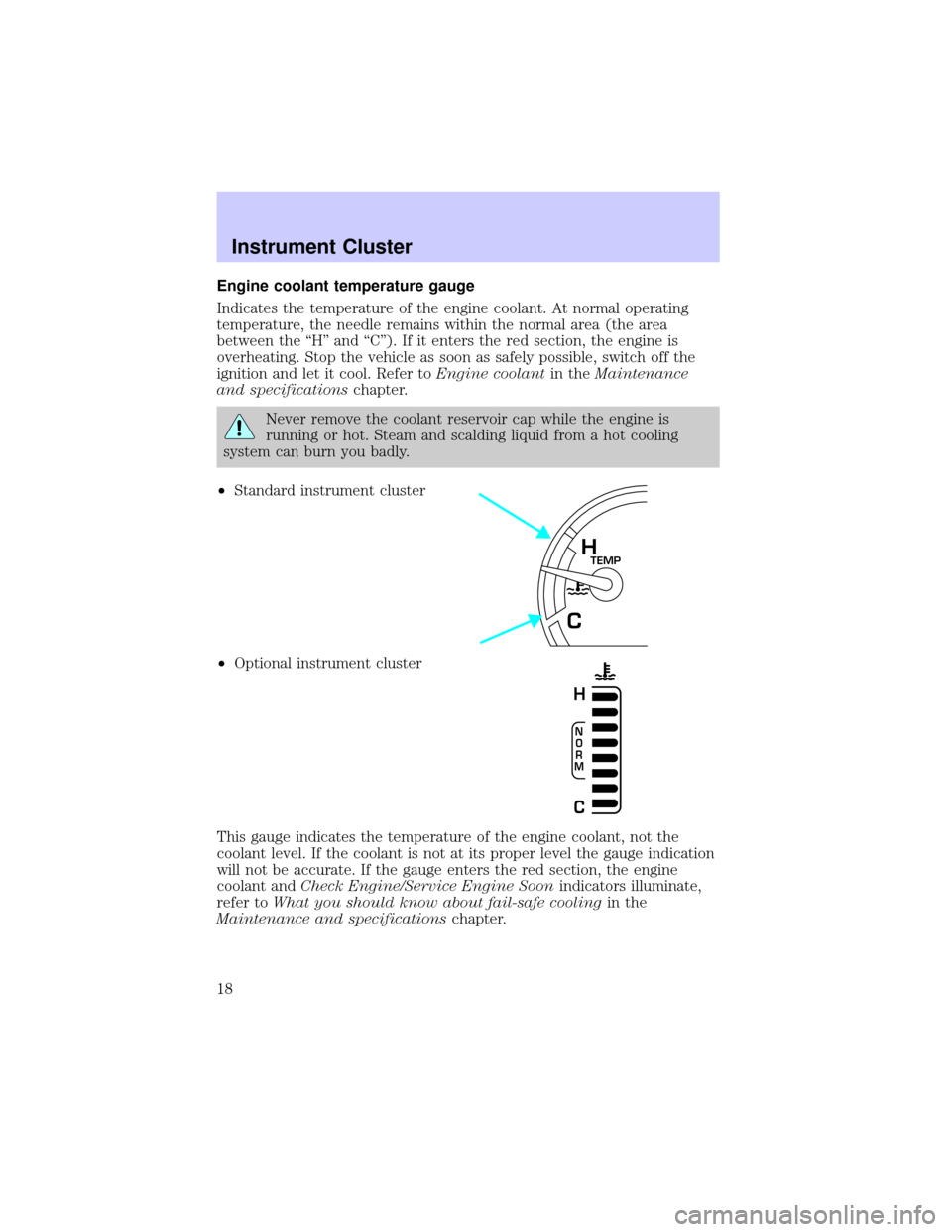
Engine coolant temperature gauge
Indicates the temperature of the engine coolant. At normal operating
temperature, the needle remains within the normal area (the area
between the ªHº and ªCº). If it enters the red section, the engine is
overheating. Stop the vehicle as soon as safely possible, switch off the
ignition and let it cool. Refer toEngine coolantin theMaintenance
and specificationschapter.
Never remove the coolant reservoir cap while the engine is
running or hot. Steam and scalding liquid from a hot cooling
system can burn you badly.
²Standard instrument cluster
²Optional instrument cluster
This gauge indicates the temperature of the engine coolant, not the
coolant level. If the coolant is not at its proper level the gauge indication
will not be accurate. If the gauge enters the red section, the engine
coolant andCheck Engine/Service Engine Soonindicators illuminate,
refer toWhat you should know about fail-safe coolingin the
Maintenance and specificationschapter.
TEMPH
C
N
O
R
M
H
C
Instrument Cluster
18
Page 141 of 248
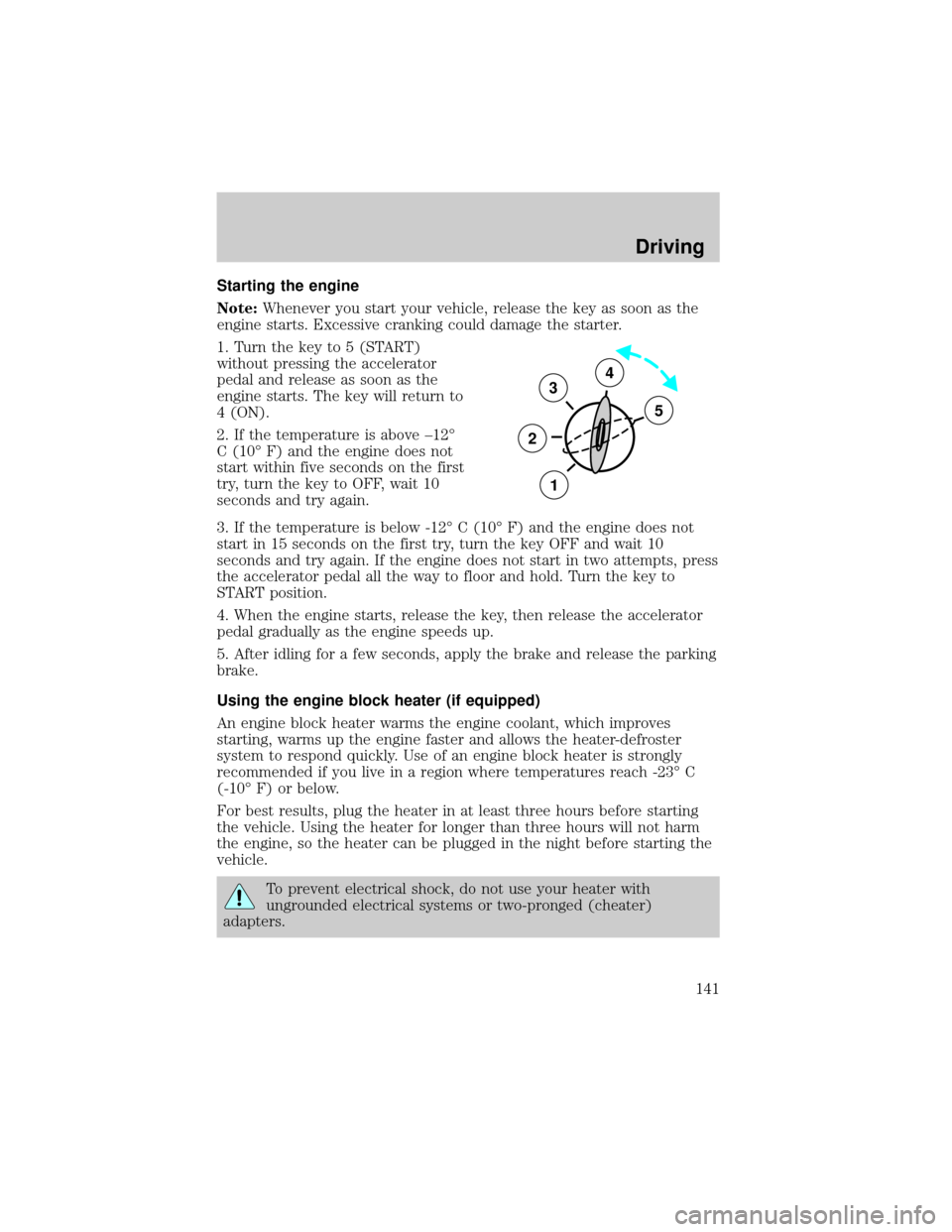
Starting the engine
Note:Whenever you start your vehicle, release the key as soon as the
engine starts. Excessive cranking could damage the starter.
1. Turn the key to 5 (START)
without pressing the accelerator
pedal and release as soon as the
engine starts. The key will return to
4 (ON).
2. If the temperature is above ±12É
C (10É F) and the engine does not
start within five seconds on the first
try, turn the key to OFF, wait 10
seconds and try again.
3. If the temperature is below -12É C (10É F) and the engine does not
start in 15 seconds on the first try, turn the key OFF and wait 10
seconds and try again. If the engine does not start in two attempts, press
the accelerator pedal all the way to floor and hold. Turn the key to
START position.
4. When the engine starts, release the key, then release the accelerator
pedal gradually as the engine speeds up.
5. After idling for a few seconds, apply the brake and release the parking
brake.
Using the engine block heater (if equipped)
An engine block heater warms the engine coolant, which improves
starting, warms up the engine faster and allows the heater-defroster
system to respond quickly. Use of an engine block heater is strongly
recommended if you live in a region where temperatures reach -23É C
(-10É F) or below.
For best results, plug the heater in at least three hours before starting
the vehicle. Using the heater for longer than three hours will not harm
the engine, so the heater can be plugged in the night before starting the
vehicle.
To prevent electrical shock, do not use your heater with
ungrounded electrical systems or two-pronged (cheater)
adapters.
3
2
1
5
4
Driving
141
Page 207 of 248
![Mercury Grand Marquis 2002 Owners Manuals Severe climates
If you drive in extremely cold climates (less than ±36É C [±34É F]):
²It may be necessary to increase the coolant concentration
above 50%.
²NEVER increase the coolant concentrati Mercury Grand Marquis 2002 Owners Manuals Severe climates
If you drive in extremely cold climates (less than ±36É C [±34É F]):
²It may be necessary to increase the coolant concentration
above 50%.
²NEVER increase the coolant concentrati](/img/33/10916/w960_10916-206.png)
Severe climates
If you drive in extremely cold climates (less than ±36É C [±34É F]):
²It may be necessary to increase the coolant concentration
above 50%.
²NEVER increase the coolant concentration above 60%.
²Increased engine coolant concentrations above 60% will
decrease the overheat protection characteristics of the engine
coolant and may cause engine damage.
²Refer to the chart on the coolant container to ensure the
coolant concentration in your vehicle will provide adequate
freeze protection at the temperatures in which you drive in the
winter months.
If you drive in extremely hot climates:
²It is still necessary to maintain the coolant concentration
above 40%.
²NEVER decrease the coolant concentration below 40%.
²Decreased engine coolant concentrations below 40% will
decrease the corrosion protection characteristics of the engine
coolant and may cause engine damage.
²Decreased engine coolant concentrations below 40% will
decrease the freeze protection characteristics of the engine
coolant and may cause engine damage.
²Refer to the chart on the coolant container to ensure the
coolant concentration in your vehicle will provide adequate
protection at the temperatures in which you drive.
Vehicles driven year-round in non-extreme climates should use a 50/50
mixture of engine coolant and distilled water for optimum cooling system
and engine protection.
What you should know about fail-safe cooling
If the engine coolant supply is depleted, this feature allows the vehicle to
be driven temporarily before incremental component damage is incurred.
The ªfail-safeº distance depends on ambient temperatures, vehicle load
and terrain.
Maintenance and Specifications
207
Page 208 of 248
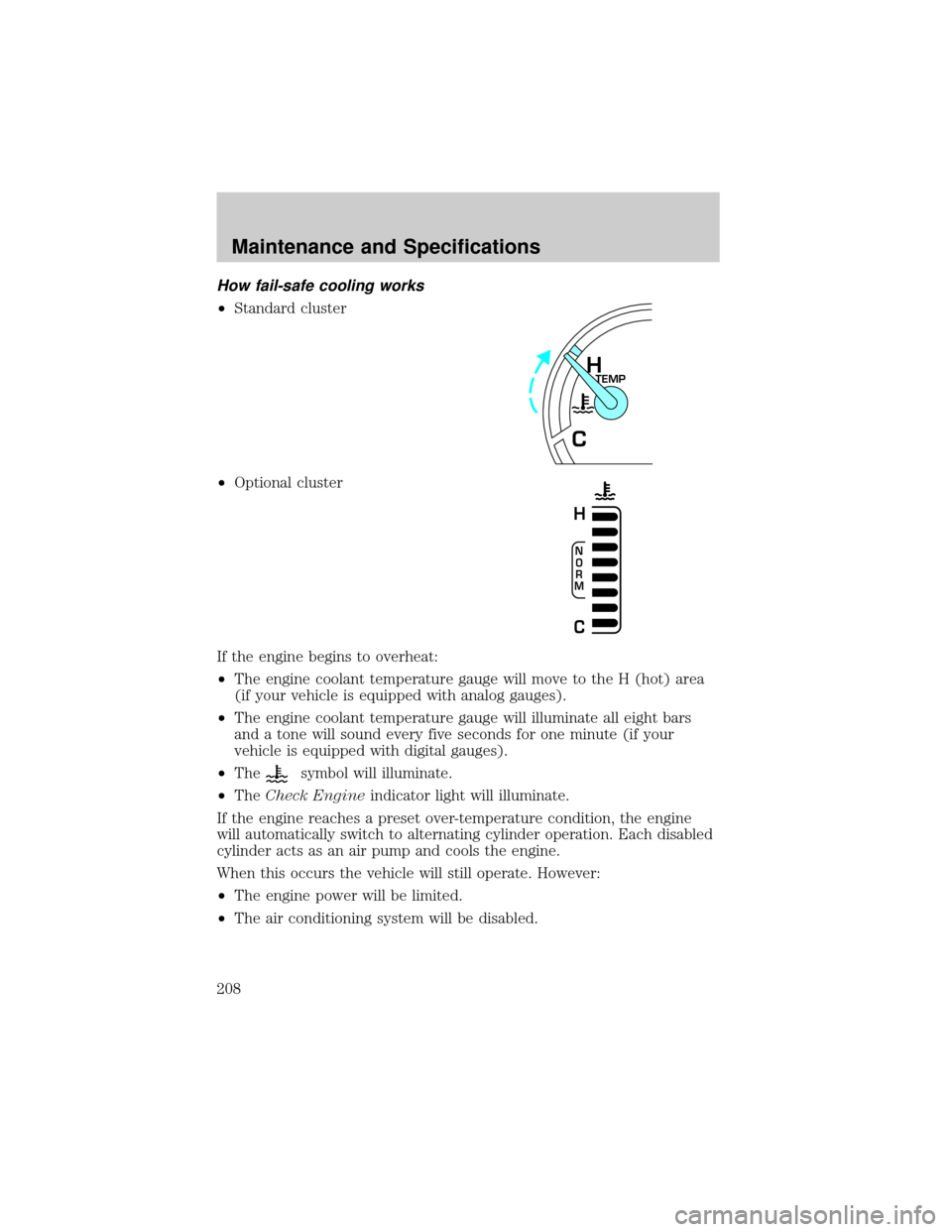
How fail-safe cooling works
²Standard cluster
²Optional cluster
If the engine begins to overheat:
²The engine coolant temperature gauge will move to the H (hot) area
(if your vehicle is equipped with analog gauges).
²The engine coolant temperature gauge will illuminate all eight bars
and a tone will sound every five seconds for one minute (if your
vehicle is equipped with digital gauges).
²The
symbol will illuminate.
²TheCheck Engineindicator light will illuminate.
If the engine reaches a preset over-temperature condition, the engine
will automatically switch to alternating cylinder operation. Each disabled
cylinder acts as an air pump and cools the engine.
When this occurs the vehicle will still operate. However:
²The engine power will be limited.
²The air conditioning system will be disabled.
TEMPH
C
N
O
R
M
H
C
Maintenance and Specifications
208
Page 209 of 248
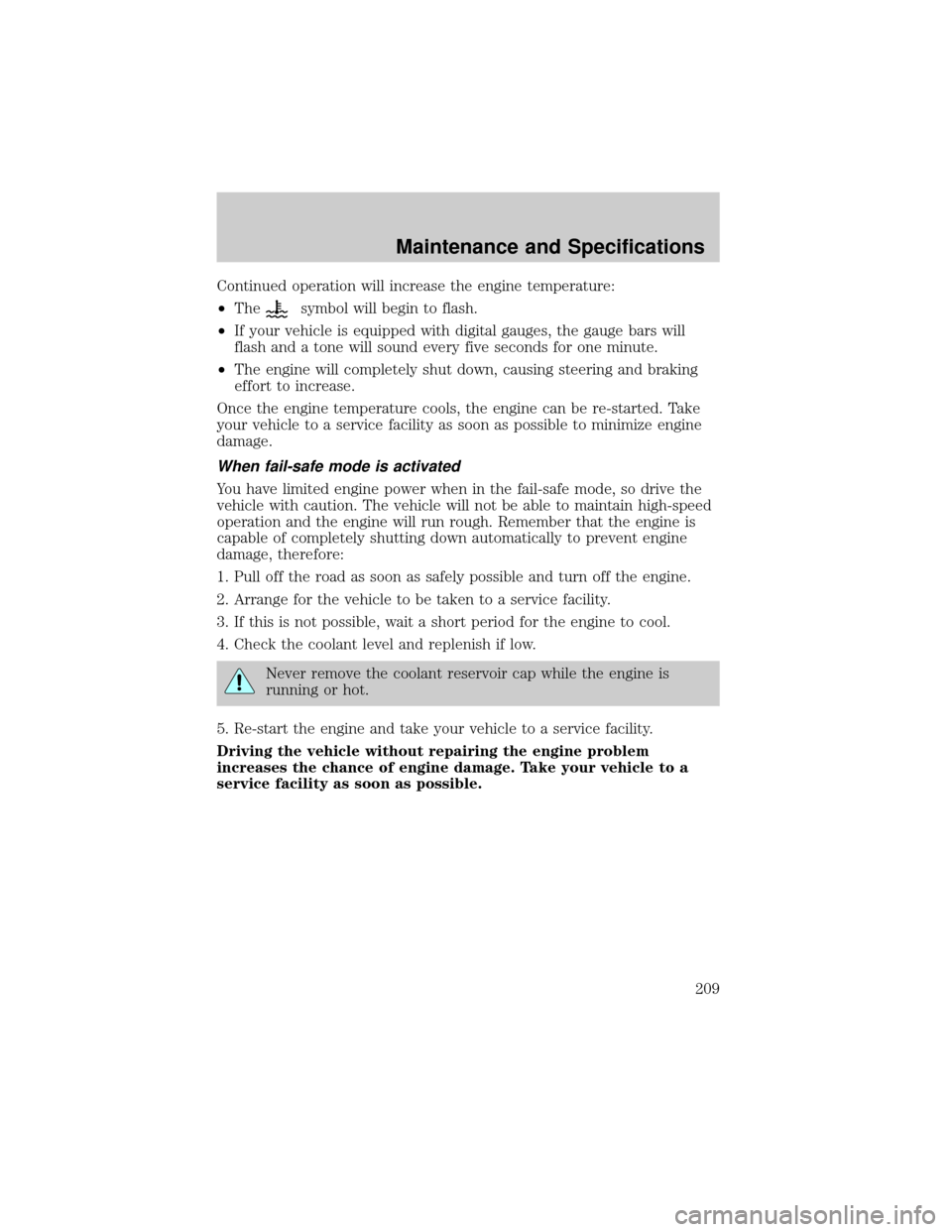
Continued operation will increase the engine temperature:
²The
symbol will begin to flash.
²If your vehicle is equipped with digital gauges, the gauge bars will
flash and a tone will sound every five seconds for one minute.
²The engine will completely shut down, causing steering and braking
effort to increase.
Once the engine temperature cools, the engine can be re-started. Take
your vehicle to a service facility as soon as possible to minimize engine
damage.
When fail-safe mode is activated
You have limited engine power when in the fail-safe mode, so drive the
vehicle with caution. The vehicle will not be able to maintain high-speed
operation and the engine will run rough. Remember that the engine is
capable of completely shutting down automatically to prevent engine
damage, therefore:
1. Pull off the road as soon as safely possible and turn off the engine.
2. Arrange for the vehicle to be taken to a service facility.
3. If this is not possible, wait a short period for the engine to cool.
4. Check the coolant level and replenish if low.
Never remove the coolant reservoir cap while the engine is
running or hot.
5. Re-start the engine and take your vehicle to a service facility.
Driving the vehicle without repairing the engine problem
increases the chance of engine damage. Take your vehicle to a
service facility as soon as possible.
Maintenance and Specifications
209
Page 220 of 248
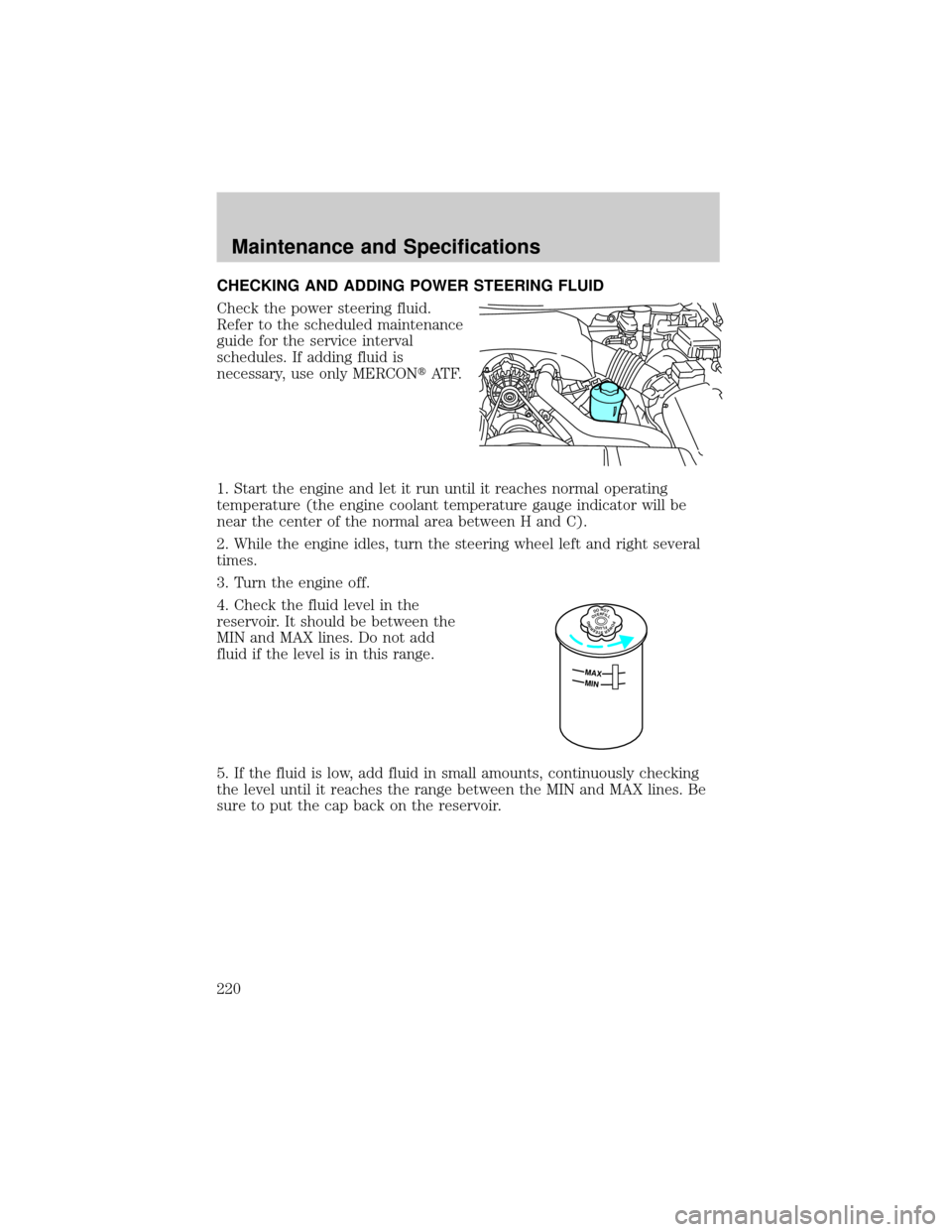
CHECKING AND ADDING POWER STEERING FLUID
Check the power steering fluid.
Refer to the scheduled maintenance
guide for the service interval
schedules. If adding fluid is
necessary, use only MERCONtAT F.
1. Start the engine and let it run until it reaches normal operating
temperature (the engine coolant temperature gauge indicator will be
near the center of the normal area between H and C).
2. While the engine idles, turn the steering wheel left and right several
times.
3. Turn the engine off.
4. Check the fluid level in the
reservoir. It should be between the
MIN and MAX lines. Do not add
fluid if the level is in this range.
5. If the fluid is low, add fluid in small amounts, continuously checking
the level until it reaches the range between the MIN and MAX lines. Be
sure to put the cap back on the reservoir.
DONOTOVERFILLPOWERSTEERINGFLUID
MAX
MIN
Maintenance and Specifications
220
Page 241 of 248

instrument panel ....................191
interior .....................................191
plastic parts ............................190
safety belts ..............................192
washing ....................................187
waxing .....................................187
wheels ......................................188
windows ..................................192
wiper blades ............................190
Clock ......................................32, 70
Compass, electronic ....................73
calibration .................................74
set zone adjustment .................73
Console ........................................91
Controls
power seat .......................108, 110
steering column ........................79
Coolant
checking and adding ..............203
coolant temperature light ........13
refill capacities ................206, 230
specifications ..................232±233
Cruise control
(see Speed control) ....................75
Customer Assistance ................158
Ford accessories for your
vehicle .....................................193
Ford Extended Service
Plan ..........................................179
Getting assistance outside the
U.S. and Canada .....................183
Getting roadside assistance ...158
Getting the service you
need .........................................177
Ordering additional owner's
literature .................................184
The Dispute Settlement
Board .......................................180Utilizing the
Mediation/Arbitration
Program ...................................183
D
Daytime running lamps
(see Lamps) ................................60
Defrost
rear window ..............................58
Dipstick
automatic transmission
fluid ..........................................222
engine oil .................................197
Doors
lubricant specifications ..........232
Driving under special
conditions
through water .........................152
E
Electronic message center .........84
Emergencies, roadside
jump-starting ..........................171
Emission control system ..........218
Engine ................................233±234
check engine/service
engine soon light ......................11
cleaning ...................................189
coolant .....................................203
fail-safe coolant ......................207
idle speed control ...................200
lubrication
specifications ..................232±233
refill capacities ........................230
service points ..........................196
starting after a collision .........160
Engine block heater .................141
Index
241
Page 242 of 248

Engine oil ..................................197
change oil soon warning,
message center .......................197
checking and adding ..............197
dipstick ....................................197
filter, specifications ........199, 230
recommendations ...................199
refill capacities ........................230
specifications ..................232±233
Exhaust fumes ..........................142
F
Fail safe cooling ........................207
Floor mats ...................................91
Fluid capacities .........................230
Fuel ............................................210
calculating fuel economy .......215
cap .....................................12, 212
capacity ...................................230
choosing the right fuel ...........213
comparisons with EPA fuel
economy estimates .................218
detergent in fuel .....................214
filling your vehicle
with fuel ..................210, 212, 215
filter, specifications ........214, 230
fuel filler door override ............90
fuel filler door release ..............90
fuel pump shut-off switch .....160
gauge .........................................20
improving fuel economy ........215
low fuel warning light ..............14
octane rating ...........213, 233±234
quality ......................................213
running out of fuel .................214
safety information relating to
automotive fuels .....................210
Fuses ..................................161±162G
Garage door opener ....................80
Gas cap (see Fuel cap) ......12, 212
Gas mileage (see Fuel
economy) ...................................215
Gauges .........................................17
battery voltage gauge ...............19
engine coolant temperature
gauge .........................................18
engine oil pressure gauge ........19
fuel gauge ..................................20
odometer ...................................21
speedometer .............................21
trip odometer ............................22
GAWR (Gross Axle Weight
Rating) .......................................153
definition .................................153
driving with a heavy load ......153
location ....................................153
GVWR (Gross Vehicle Weight
Rating) .......................................153
calculating ...............................153
definition .................................153
driving with a heavy load ......153
location ....................................153
H
Hazard flashers .........................159
Head restraints .........................106
Headlamps ...................................59
aiming ........................................61
autolamp system .......................59
bulb specifications ....................62
daytime running lights .............60
flash to pass ..............................60
high beam ...........................15, 60
replacing bulbs .........................63
Index
242